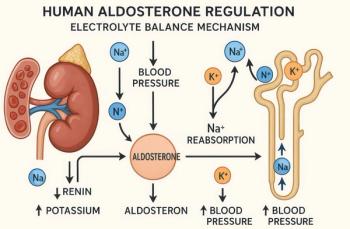
Renal Artery Stenosis: When to Order Diagnostic Tests-When to Intervene?
In imaging studies in patients older than 55 yearswith suspected coronary artery disease or peripheralvascular disease, more than 80% of renal artery lesionsare associated with generalized atherosclerosis.
Q: An arteriogram revealed moderate unilateral renal artery stenosis in a 70-year-old man with controlled hypertension and coronary artery disease. How should this be managed?
A: In imaging studies in patients older than 55 years with suspected coronary artery disease or peripheral vascular disease, more than 80% of renal artery lesions are associated with generalized atherosclerosis. Studies show that in patients with coronary artery disease, about 15% to 20% demonstrate associated renal artery lesions. Main renal artery disease may be detected in up to 50% of patients with documented peripheral vascular disease. Although many of these lesions are of minor hemodynamic significance, it is nevertheless a challenge to determine which diagnostic studies are warranted and, in some cases, to assess the risks and benefits of revascularization.
Lesions that cause vessel occlusion of more than 60% are likely to induce changes in renal blood flow and organ profusion, leading to activation of the renin-angiotensin system with subsequent rise in blood pressure (BP). If BP is easily controlled, particularly with agents that block the renin-angiotensin system, and if renal function remains normal, no further intervention is needed. Progression of stenosis may result in treatment-resistant hypertension, loss of kidney function (usually bilateral stenosis), or episodes of "flash pulmonary edema," all of which require further evaluation and possible vascular intervention.
The number of interventions performed in patients with moderate renal artery stenosis and normal renal function in whom BP is normal or well controlled has increased.1 However, the appearance of renal artery stenosis on an imaging procedure does not help predict the likelihood of progressive stenosis, and percutaneous vascular interventions in these patients should be discouraged. Consideration of vascular intervention is best reserved for patients with treatment-refractory hypertension and/or clear evidence of declining renal function as a result of ischemic nephropathy.2 Improved cardiovascular survival in these patients is also an obvious goal. Unfortunately, long-term outcomes data for this patient population are not available.
Diagnostic studies. Screening and diagnostic studies have evolved. Stimulated renin profiling is no longer recommended because it has no imaging value and is not sufficiently specific. Renal angiography, the gold standard for visualization of the renal arteries, is an invasive procedure that is not without risk, particularly in a patient with generalized atherosclerosis. At the Cleveland Clinic, we perform angiography as a baseline procedure when a patient undergoes revascularization. Isotope renography, although highly sensitive, is not suitably specific, particularly in patients with impaired renal function. We have found that screening Doppler ultrasonography correlates well with renal angiography. However, results depend on the expertise of the technician, and the procedure is time-consuming.
Correlation in many laboratories is not sufficient. Magnetic resonance angiography with a nontoxic contrast agent such as gadolinium provides excellent vascular imaging, although caution is advised in patients with moderate to severe renal insufficiency. CT angiography also provides excellent imaging, but it requires an iodinated contrast agent.3,4
Risks and benefits of revascularization. Percutaneous renal angioplasty with or without metallic stenting is the most common renal artery revascularization procedure. Nevertheless, the benefits of this intervention are controversial because results demonstrate only modest benefit for BP and preservation of renal function. In fact, progression to total occlusion and loss of kidney function is uncommon with atherosclerotic disease, and it has been suggested that patients do as well with medical treatment, particularly if BP can be adequately controlled. Some patients demonstrate improvement in refractory or accelerated hypertension following revascularization, with limited evidence of improved renal function. This small benefit must be balanced against the potential complications of the procedure, which include cholesterol embolization to the kidney or extremities, renal artery perforation, and occasional occlusion, along with a 15% to 20% risk of restenosis over the course of 6 to 12 months.
About 2 years ago, the NIH instituted a large, prospective multicenter trial of atherosclerotic renal artery disease (the Cardiovascular Outcomes with Renal Atherosclerotic Lesions [CORAL] study).5 Its primary goal is to evaluate cardiovascular and renal outcomes of patients randomized to intensive medical therapy, with or without percutaneous angioplasty and stenting. Results are expected later this year.
References:
REFERENCES:1.Murphy T, Soares G, Kim H. Increase in utilization of percutaneous renal artery interventions by medicare beneficiaries, 1996-2000. AJR. 2004;183:561-568.
2. Textor SC. Renovascular hypertension update. Curr Hypertens Rep. 2006;8: 521-527.
3. Vasbinder GB, Nelemans PJ, Kessels AG, et al. Diagnostic tests for renal artery stenosis in patients suspected of having renovascular hypertension: a meta-analysis. Ann Intern Med. 2001;135:401-411.
4. Gandy SJ, Sudarshan TA, Sheppard DG, et al. Dynamic MRI contrast enhancement of renal cortex: a functional assessment of renovascular disease in patients with renal artery stenosis. J Magn Reson Imaging. 2003;18:461-466.
5. Murphy TP, Cooper CJ, Dworkin LD, et al. The Cardiovascular Outcomes with Renal Atherosclerotic Lesions (CORAL) study: rationale and methods. J Vasc Interv Radiol. 2005;16:1295-1300.
Newsletter
Enhance your clinical practice with the Patient Care newsletter, offering the latest evidence-based guidelines, diagnostic insights, and treatment strategies for primary care physicians.



















































































































































































































































































